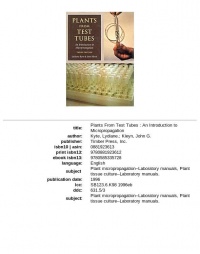DIY Plant Tissue culture and Engineering
Plant Tissue Culturing
For the purpose of creating newly grown leaves from leaf cuttings, in-vitro
Plants from Test Tubes is a great book to get started. Download here: File:Plants From Test Tubes Complete.pdfMaterials and Equipment Needed
For making the plates:
Petri dishes
Erlenmeyer Flasks
Graduated Cylinders
Scale and Measuring Accessories
Magnetic Stirrer
Pipettes and Tips
Foil
Agar
Ionized water
Sucrose
Thiamine
Murashige + Skoog Packets
pH Meter
Autoclave
NAA (naphthaleneacetic acid)
BAP (benzyladenine)
For sterilizing the leaves:
Sterile Hood
Sterilized Water
Empty Sterilized Petri Dishes
Beakers
Bleach
Liquid Detergent (Household OK)
70% Alcohol
Flame
Forceps
Tweezers
Sterile gloves
Parafilm
Freshly cut Nicotiana Tabacum Leaves
Protocol
Preparing the plates Medium for 1L
4.3g of Murashige and Skoog w/Gamborgs Vitamins
20g of Sucrose
1% weight/volume of agar
1L of water
Pour into a flask or beaker that can hold that much medium without boiling over
Place on a magnetic stirrer until everything is dissolved
Adjust the pH to approximately 5.7
Autoclave for 20 min in a slow-exhaust liquid cycle. Let cool 15-20 minutes
Add 100 µl Naphtalene Acetic Acid (NAA) [1mg/ml] and 1 ml 6-Benzacyl Aminopurine (6-BAP) [1mg/ml]
You may wish to add antibiotics and antimycotics at this time
Thoroughly wash hands, put on sterile gloves and in a sterile hood:
Make sure to gently swirl the flask before pouring, to keep the agar from settling
Pour plates
Let cool with sterile air blowing over it and the lids off. Once the agar has set, place the lids and leave in a sterile hood until its time to place the leaf tissue
Sterilizing the leaves
In the sterile hood:
250ml beaker containing 100ml of 70% concentration alcohol
Sterile petri dishes for rinsing sterilized leaf cuttings
Sterile petri dish for holding sterilized leaves ready to be placed
500ml beaker containing 200ml bleach and one drop of liquid detergent
500ml beaker containing autoclaved sterile water
Matchbook to light the flame
Agar plates
Parafilm or Micro-pore tape
Immerse the cut leaves in the bleach solution for 5 minutes
Swirl in 70% alcohol for 10 seconds
Rinse in sterile water
Transfer to a second sterile water rinse
Use the sterile forceps and tweezers to place the leaf cuttings onto your agar plates.
Cover and seal with Parafilm/Micro-pore tape
Some more links
Kitchen culture kit: http://www.kitchenculturekit.com/ Archive
discussion on maillist
growing fungi: http://makeprojects.com/Project/Home-Mycology-Lab/242/1
general vocabulary: http://mansfield.osu.edu/~sabedon/biol4035.htm#petri_dish
http://edgeqld.org.au/2013/01/plant-cell-culture/
http://www.scq.ubc.ca/your-guide-to-plant-cell-culture/
How to make slants and stabs:
- In a 400 ml beaker, make about 100 ml of Nutrient agar (but use only about half of the powder that the instructions on the label call for. Heat this until it boils (microwaving is the preferred method but you must watch it closely as it will sudden burst into foam). If heating it in a pan on a hotplate, swirl constantly while heating (pretend it is gravy, which you don't want to burn). It seems best to then pour the stuff from the pan into the beaker, and then pour from that into screw-topped culture tubes - fill the tubes about 1/4 full. Put on the caps almost tight and then autoclave to sterilize.
- Slants: Take tubes immediately out of the autoclave and find the right place to set them on a rather flat incline so that the proper 'slant' is achieved for them to solidify. Once cool and solid, screw caps on tightly to prevent evaporation. Longevity: cultures in slants last for several years if they are stored in the dark and do not dry out.
- Stabs: fill tubes 1/3 full, cap and sterilize. Stand them vertically to solidify. When cool, screw caps on tightly. To inoculate these, stab an inoculated loop down into the agar for about 2/3 way to bottom. Stabs preserve most bacteria for years and years in the dark if the caps are airtight and evaporation doesn't occur.
- Always store cultures in the dark as UV damage accrues from fluorescent lights and sunlight.
